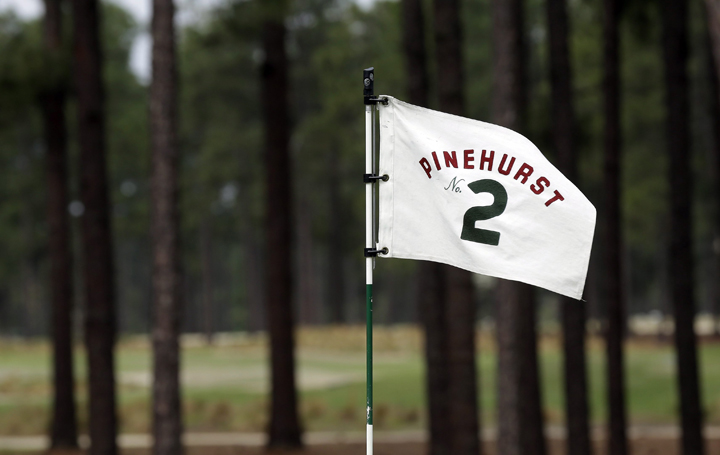To many, Pinehurst No. 2 is the masterwork of Scottish architect Donald Ross. Public golfers pay up to US$410 to be beaten up by the course, and to try, often without much success, to putt on its famed domed greens.

But in reality, the course—which hosts this week’s U.S. Open and is regarded as “the St. Andrews of American golf”—is a supreme test of all facets of the game, which is why it is perennially ranked among the best golf courses in the world. And for this U.S. Open it has been tweaked by architect Bill Coore and Ben Crenshaw to create a more natural look, with wayward tee shots rolling into sandy expanses.
Already great, somehow Pinehurst No. 2 managed to get better and will appear quite different from 2005 when New Zealander Michael Campbell held off Tiger Woods to win the tournament.
Neither Campbell, who had personal issues and withdrew from the tournament, nor Woods, who is injured, will be in the field this week, but that means Pinehurst No. 2’s star turn is that much more important. The course will play an important role not only in the men’s event, but also in the Women’s U.S. Open, which for the first time will be played on the same course next week.
Graham DeLaet is the only Canadian in the field.
“It is a true test of all the parts of your game, more than any other course I’ve played,” DeLaet said. “Everything is a little scary once you get out on that golf course.”
For DeLaet, the course might play into his strength, which is finding greens, though the putting surfaces are notoriously difficult. What’s the winning score on such a beast of a course? DeLaet didn’t even want to hazard a guess, but admitted even par would be solid.
“If I see even par I’d be really happen and might even be drinking beer out of the U.S. Open cup,” he suggested.
Canadian golf architect Ian Andrew, a member of the American Society of Golf Architects, argues that Pinehurst No. 2 is the standard against which all golf courses are designed.
“It is almost the perfect example of what a golf course should be,” said Andrew. “It is difficult for the good player to score well there, but if the lesser player is not as aggressive, they can post a good number. The more aggressive you get, the nastier the punishment for failure becomes. It is a flawless course.”
Even before it gained international attention for hosting the 1999 U.S. Open, Pinehurst was recognized most for its difficult greens, which some characterize as unfair.
Unlike the majority of putting surfaces you’ll find on courses, which offer rolls within a subtly undulating surface, Pinehurst’s greens appear like inverted bowls, rounded at the top with edges that slide away. However, the greens at Pinehurst, which have come to be representative of Ross’ style, actually have little to do with the architect.
It was famed golf designer Pete Dye who first pointed out Pinehurst No. 2’s greens had evolved since Ross created the course in 1935 as a resort destination. Dye, who first played the course nearly 50 years ago, said the greens were far less severe than they are currently.
Dye’s notion was supported by a Golf Digest story by architecture editor Ron Whitten that suggested the greens had been altered several times over the past few decades, most recently by Rees Jones in preparation for the 1999 U.S. Open. Coore and Crenshaw didn’t tweak the greens, instead creating naturalized areas using native grasses.
Whitten argues that the greens built up over time due to maintenance procedures, but rather than having curved sides, as they do today, the fall-off areas were once more severe. A previous owner of the course, for reasons no one is certain of, used a bulldozer to smooth the edges and make the fall-off areas more curved.
The diabolical nature of the greens was highlighted in 1999 when the best golfers in the world last tested Pinehurst No. 2 under U.S. Open conditions. Most notably the troubled John Daly struggled mightily with the testy surfaces, and on the eighth hole in his final round, Daly lost it, taking a total of 11 strokes. Daly’s most notable meltdown on the hole occurred when he swiped at a ball that was rolling back off the putting area, incurring a two-stroke penalty.
Daly complained loudly after his round, saying the United States Golf Association, which sets up the course for the tournament, had gone too far.
“I think the USGA likes to embarrass people who play in this tournament,” he said.
Many have difficulty seeing the course as great. Rather, they view it as relatively straight-forward tee-to-green, with unfair putting surfaces.
Despite its detractors, Pinehurst’s greens were central to the drama of the 1999 U.S. Open, won by Payne Stewart. Stewart holed a remarkable, snaking 20-foot putt on the final hole to make par and win the championship, narrowly avoiding a Monday playoff with Phil Mickelson.
“I said to myself, ‘You’ve always wanted a putt to win the U.S. Open,’” Stewart noted following his victory. “I can’t describe the feeling in my body when I looked up and the ball was going in the hole. It was unbelievable.”
Expect more unbelievable moments this year, as the best in golf challenge what many think is one of the best and most difficult golf courses created.




Comments